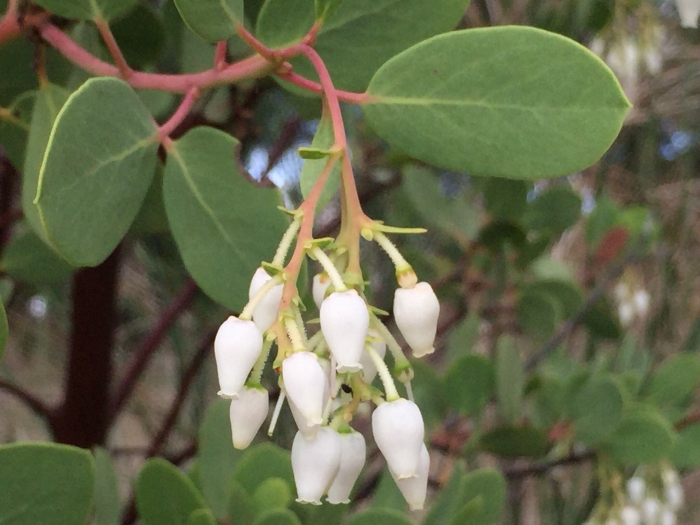Bigberry Manzanita
(Arctostaphylos glauca)
Bigberry Manzanita (Arctostaphylos glauca)
/
/

rappman
CC BY 4.0
Image By:
rappman
Recorded By:
Copyright:
CC BY 4.0
Copyright Notice:
Photo by: rappman | License Type: CC BY 4.0 | License URL: http://creativecommons.org/licenses/by/4.0/ | Rights Holder: rappman | Publisher: iNaturalist | Date Created: 2016-11-15T22:20:27Z |






















Estimated Native Range
Summary
Arctostaphylos glauca, commonly known as Bigberry Manzanita, is an evergreen shrub native to the chaparral and oak woodlands of California and Baja California. It exhibits a wide range of sizes, from 3 to over 20 feet in height, and is noted for its smooth, reddish-brown bark and light gray-green, waxy leaves. The Bigberry Manzanita blooms from winter to early spring, producing showy clusters of white to pinkish urn-shaped flowers, which are followed by large, edible, round or egg-shaped red drupes that are among the largest in the genus.
The plant is valued for its ornamental features, including its attractive bark and flowers, and its ability to thrive in dry, well-drained soils. It is often used in native plant gardens, as a focal point in landscapes, and for erosion control on slopes. Bigberry Manzanita prefers full sun to partial shade and requires little water once established, making it suitable for xeriscaping. It is also beneficial for wildlife, providing food and habitat. However, gardeners should be aware of its allelopathic properties, which can suppress the growth of nearby plants. Additionally, the seeds have a fire-dependent germination strategy, reflecting the plant’s adaptation to its fire-prone native habitat. While generally disease-resistant, it can be susceptible to fungal diseases in poorly drained soils.CC BY-SA 4.0
The plant is valued for its ornamental features, including its attractive bark and flowers, and its ability to thrive in dry, well-drained soils. It is often used in native plant gardens, as a focal point in landscapes, and for erosion control on slopes. Bigberry Manzanita prefers full sun to partial shade and requires little water once established, making it suitable for xeriscaping. It is also beneficial for wildlife, providing food and habitat. However, gardeners should be aware of its allelopathic properties, which can suppress the growth of nearby plants. Additionally, the seeds have a fire-dependent germination strategy, reflecting the plant’s adaptation to its fire-prone native habitat. While generally disease-resistant, it can be susceptible to fungal diseases in poorly drained soils.CC BY-SA 4.0
Plant Description
- Plant Type: Shrubs, Trees
- Height: 15-20 feet
- Width: 15-20 feet
- Growth Rate: Slow
- Flower Color: Pink, White
- Flowering Season: Spring, Winter
- Leaf Retention: Evergreen
Growth Requirements
- Sun: Full Sun, Part Shade
- Water: Low, Medium
- Drainage: Fast, Medium
Common Uses
Bee Garden, Bird Garden, Drought Tolerant, Hummingbird Garden, Showy Flowers
Natural Habitat
Native to the chaparral and oak woodlands of California and Baja California
Other Names
Common Names: Glaucous Manzanita , Blue Manzanita
Scientific Names: Arctostaphylos glauca , Arctostaphylos glauca f. adenopuberula , Arctostaphylos glauca f. eremicola , Arctostaphylos glauca f. puberula , Arctostaphylos glauca var. eremicola , Arctostaphylos glauca var. glauca , Arctostaphylos glauca var. puberula , Daphnidostaphylis glauca , Uva-ursi glauca , Xerobotrys glaucus
GBIF Accepted Name: